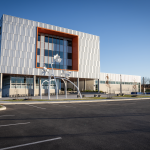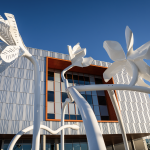

Marie-Michelle Deschamps’ work focuses on language as inhabitable space: a true structure and a place where aesthetic forms reside. Her practice is rooted in conversation, collaboration and translation, emphasizing the transformative power of language in the formal dialect of architecture.
Marie-Michelle Deschamps is based in Montreal, Canada, and holds an MFA from the Glasgow School of Art (Glasgow, Scotland). Works by Marie-Michelle Deschamps are included in the permanent collections of the Musée d’art contemporain de Montréal, the Musée Voorlinden (Wassenaar), the Fondation Lafayette (Paris), the Glasgow School of the Arts (Glasgow), the Enamel Arts Foundation (Los Angeles) and the Caisse de dépôt et placement du Québec (Montreal).

Artwork description
450 million years ago, Montreal was located in the tropics, at the Equator. A deep sea flooded the St. Lawrence lowlands. It was teeming with marine organisms that, as they died, settled to the bottom. These were the only living things on Earth, because the toxic atmosphere didn’t allow life to develop outside the water.” Gradually, invertebrate carcasses and sediments accumulated, forming limestone deposits that turned into sedimentary rock, trapping the organisms that lived there in fossil form, leaving an everlasting trace of the marine fauna that once lived here.
In this warm sea, crinoids (from the Greek krinon, lily, and eidos, form) were found in great numbers. Crinoids are small, sessile marine organisms belonging to the echinoderm family. They resemble flowers in that their crown (head) is located at the end of a stem, and their arms resemble petals (a shape to which they owe their common name of “Lys de mer”).



